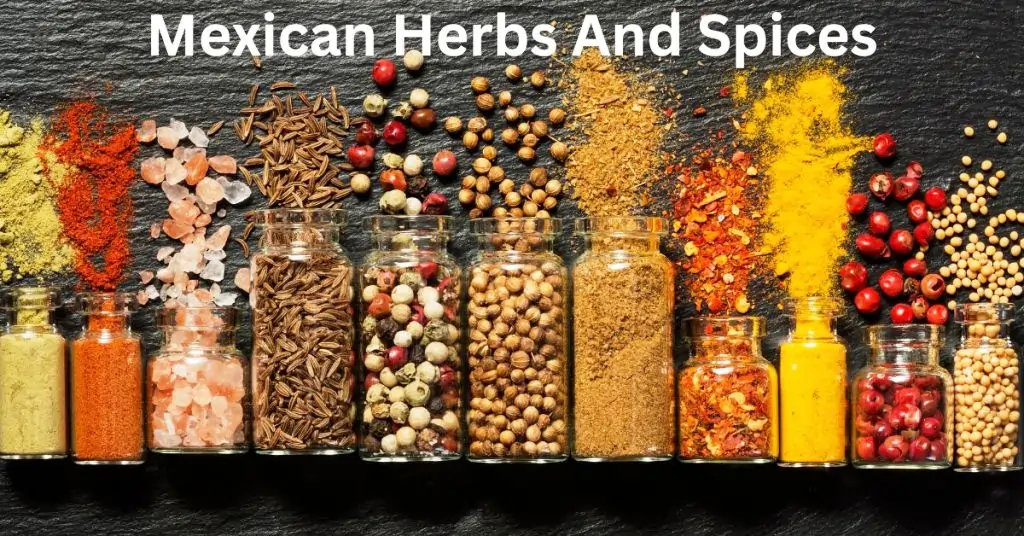Traditional Mexican Herbs And Spices
Mexican cuisine is renowned for its bold and vibrant flavors, thanks in large part to the use of a variety of herbs and spices. From fiery chili powder to aromatic cilantro, each ingredient adds its unique touch to the dishes it’s used in, resulting in a complex and satisfying taste. In this blog post, we’ll take a closer look at seven essential Mexican herbs and spices that can help take your cooking to the next level. Whether you’re a seasoned chef or a home cook looking to experiment with new flavors, these ingredients are sure to spice up your recipes and excite your taste buds. So let’s dive in and discover the magic of Mexican herbs and spices!
Importance of Herbs and Spices in Cooking
Herbs and spices play an essential role in cooking, enhancing the flavor and aroma of dishes in a way that can elevate even the most simple recipes. In addition to their taste-boosting properties, herbs and spices also offer a range of health benefits. These ingredients contain powerful antioxidants, anti-inflammatory compounds, and essential oils that can improve digestion, boost the immune system, and potentially reduce the risk of chronic diseases.
By using herbs and spices in cooking, you can add flavor without relying on unhealthy ingredients like sugar and fat. Ultimately, incorporating herbs and spices into your cooking is a simple and effective way to add both taste and nutrition to your meals.
Mexican cuisine and its signature flavors
Mexican cuisine is celebrated for its bold, vibrant flavors and has gained popularity worldwide. The cuisine is a fusion of indigenous ingredients and cooking techniques with Spanish colonial influences. Mexican dishes come in a variety of forms, from savory tacos and enchiladas to hearty stews and soups. Chili peppers, cumin, cilantro, garlic, lime, and other herbs and spices are prominent in Mexican cuisine, creating a complex and unique taste that pairs well with staples like rice, beans, and tortillas. Mexican cuisine is not only delicious but also has a rich cultural heritage that can be explored through its food.
Top 7 Mexican herbs and spices to use in cooking
If you are a fan of Mexican cuisine or just looking to add some variety to your cooking, incorporating Mexican herbs and spices into your recipes is an excellent way to do so. Mexican cuisine is famous for its bold, spicy, and flavorful dishes, and the use of herbs and spices is an integral part of achieving those tastes. From the pungent heat of chili peppers to the earthy warmth of cumin and the bright freshness of cilantro, Mexican herbs and spices can take your cooking to the next level. In this article, we will explore the top 7 Mexican herbs and spices to use in your cooking and how they can enhance the flavor and nutrition of your dishes.
Chili powder
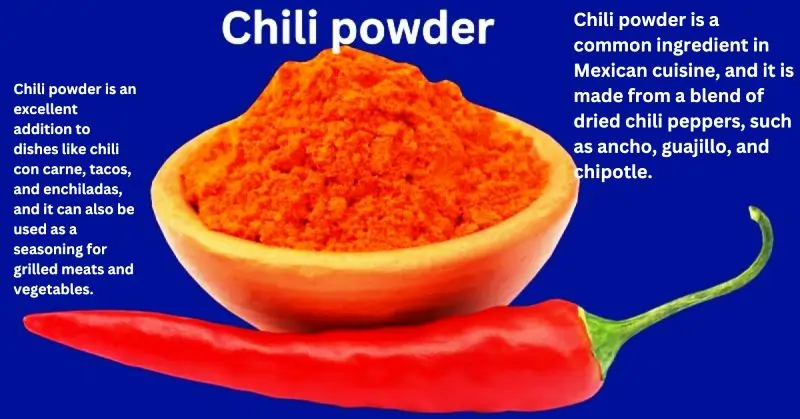
Chili powder is a common ingredient in Mexican cuisine, and it is made from a blend of dried chili peppers, such as ancho, guajillo, and chipotle. Chili powder has a complex flavor profile, with a slightly sweet and smoky taste, along with a moderate level of heat. The level of spiciness can vary depending on the type and amount of chili peppers used in the blend. Chili powder is an excellent addition to dishes like chili con carne, tacos, and enchiladas, and it can also be used as a seasoning for grilled meats and vegetables. When using chili powder, it’s essential to start with a small amount and gradually add more, as its spiciness can quickly become overpowering.
Recipes that use chili powder
Here are three recipe ideas that use chili powder:
- Chili con Carne: Chili con carne is a classic Mexican dish that features ground beef, tomatoes, onions, and kidney beans, seasoned with chili powder, cumin, and other herbs and spices. The chili powder adds a smoky, spicy flavor to the dish, and the kidney beans provide a good source of protein and fiber.
- Spicy roasted vegetables: Roasting vegetables is a great way to bring out their natural sweetness and add depth of flavor. To give them a spicy kick, sprinkle them with a mixture of chili powder, paprika, garlic powder, and salt before roasting. This works well with vegetables like sweet potatoes, carrots, and bell peppers.
- Taco seasoning: Making your own taco seasoning is easy and ensures that you know exactly what’s going into it. A simple recipe might include chili powder, cumin, garlic powder, onion powder, and salt. Use this seasoning to flavor ground beef or chicken for tacos, or sprinkle it on roasted vegetables for a Mexican-inspired side dish.
Cilantro
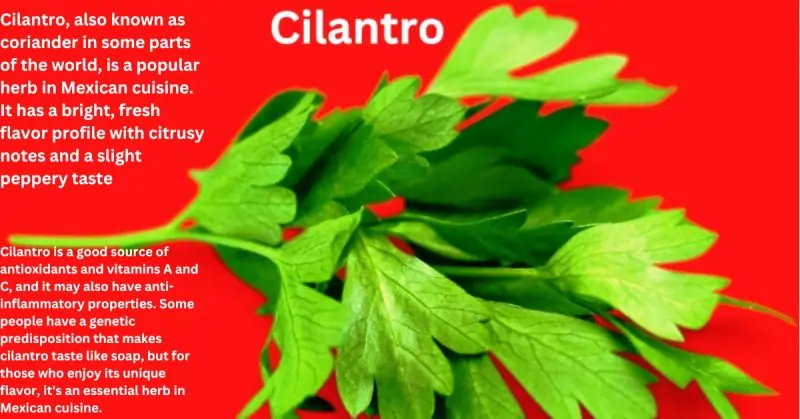
Cilantro, also known as coriander in some parts of the world, is a popular herb in Mexican cuisine. It has a bright, fresh flavor profile with citrusy notes and a slight peppery taste. Cilantro leaves are often used to add flavor to salsas, guacamole, and other dips and sauces, as well as in marinades and dressings. The seeds of the cilantro plant, which are called coriander, are also used as a spice in Mexican cooking.
Cilantro is a good source of antioxidants and vitamins A and C, and it may also have anti-inflammatory properties. Some people have a genetic predisposition that makes cilantro taste like soap, but for those who enjoy its unique flavor, it’s an essential herb in Mexican cuisine.
Recipes that use cilantro
Here are three recipe ideas that use cilantro:
- Fresh Salsa: Fresh salsa is a staple in Mexican cuisine, and cilantro is one of the key ingredients that gives it its distinctive flavor. To make fresh salsa, chop up tomatoes, onions, jalapeños, and cilantro, and mix them together with lime juice, salt, and pepper. Serve with tortilla chips or use as a topping for tacos or grilled meats.
- Cilantro Lime Chicken: Cilantro and lime are a classic flavor combination in Mexican cooking, and they work particularly well with grilled chicken. Marinate chicken breasts in a mixture of lime juice, olive oil, garlic, and cilantro, and grill until cooked through. Serve with rice and black beans for a complete meal.
- Avocado Cilantro Dressing: Creamy avocado and fresh cilantro make a delicious salad dressing that’s perfect for adding flavor to a variety of dishes. To make avocado cilantro dressing, blend together avocado, cilantro, lime juice, garlic, olive oil, and salt until smooth. Use as a dressing for salads or as a dip for veggies.
Cumin
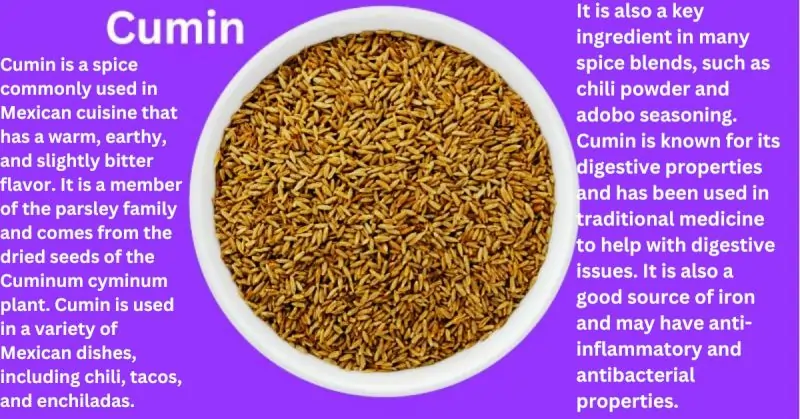
Cumin is a spice commonly used in Mexican cuisine that has a warm, earthy, and slightly bitter flavor. It is a member of the parsley family and comes from the dried seeds of the Cuminum cyminum plant. Cumin is used in a variety of Mexican dishes, including chili, tacos, and enchiladas. It is also a key ingredient in many spice blends, such as chili powder and adobo seasoning. Cumin is known for its digestive properties and has been used in traditional medicine to help with digestive issues. It is also a good source of iron and may have anti-inflammatory and antibacterial properties.
Recipes that use cumin
Here are three recipe ideas that use cumin:
- Chili: Chili is a classic Mexican dish that uses cumin to give it its signature flavor. Brown ground beef or turkey with onions and garlic, and then add canned tomatoes, kidney beans, chili powder, and cumin. Simmer for an hour or more until the flavors have melded together.
- Tacos: Tacos are another Mexican favorite that use cumin to add depth to the filling. Brown ground beef or chicken with onions and garlic, and then add cumin, chili powder, salt, and pepper. Serve the meat in warm tortillas with toppings like shredded lettuce, diced tomatoes, and shredded cheese.
- Roasted Vegetables: Cumin can also be used to add flavor to roasted vegetables. Toss sliced carrots, sweet potatoes, and onions in olive oil, cumin, salt, and pepper. Roast in the oven at 400 degrees Fahrenheit for 20-30 minutes, or until the vegetables are tender and golden brown. Serve as a side dish or as a vegetarian main course.
Oregano
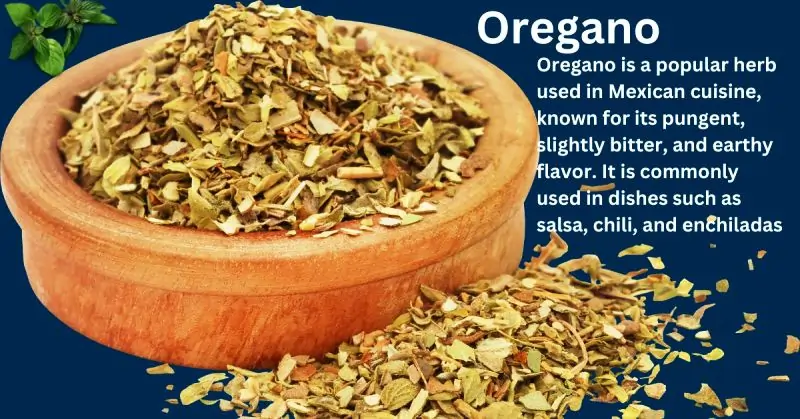
Oregano is a popular herb used in Mexican cuisine, known for its pungent, slightly bitter, and earthy flavor. It is commonly used in dishes such as salsa, chili, and enchiladas. Oregano is a member of the mint family and is native to the Mediterranean region. Mexican oregano, which has a more pungent and less sweet taste compared to Mediterranean oregano, is typically used in Mexican dishes. Oregano is also known for its health benefits, as it contains antioxidants and anti-inflammatory compounds.
Recipes that use oregano
Here are three recipe ideas that use oregano:
- Salsa: Oregano is a key ingredient in many Mexican salsas. To make a simple salsa, blend together diced tomatoes, jalapenos, onions, garlic, and oregano in a food processor. Season with salt and pepper to taste.
- Enchiladas: Oregano is often used in the tomato-based sauce used to smother enchiladas. To make the sauce, sauté onions and garlic in a saucepan, then add canned tomatoes, chicken broth, and oregano. Simmer the sauce for about 10 minutes, or until it has thickened slightly. Use the sauce to smother rolled tortillas filled with chicken or beef.
- Tostadas: Oregano can also be used as a seasoning for the meat in tostadas. Brown ground beef or turkey in a skillet with onions, garlic, and oregano. Spread refried beans onto a crispy tostada shell, top with the seasoned meat, shredded lettuce, diced tomatoes, and shredded cheese.
Paprika
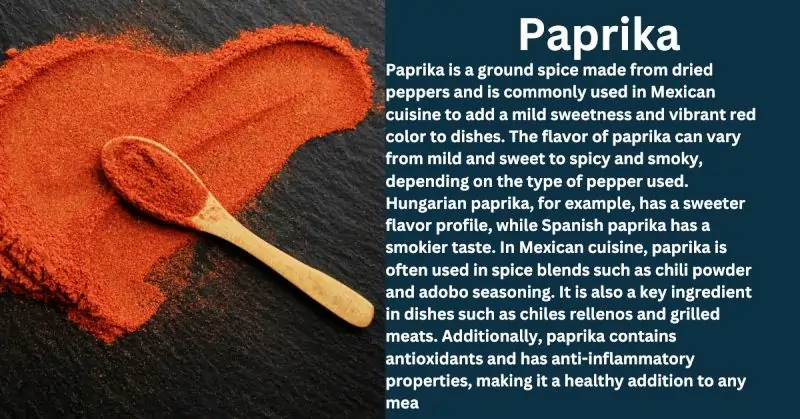
Paprika is a ground spice made from dried peppers and is commonly used in Mexican cuisine to add a mild sweetness and vibrant red color to dishes. The flavor of paprika can vary from mild and sweet to spicy and smoky, depending on the type of pepper used. Hungarian paprika, for example, has a sweeter flavor profile, while Spanish paprika has a smokier taste. In Mexican cuisine, paprika is often used in spice blends such as chili powder and adobo seasoning. It is also a key ingredient in dishes such as chiles rellenos and grilled meats. Additionally, paprika contains antioxidants and has anti-inflammatory properties, making it a healthy addition to any meal.
Recipes that use paprika
There are many recipes in Mexican cuisine that use paprika, including:
- Chiles Rellenos: This classic dish involves stuffing roasted poblano peppers with cheese, then dipping them in a paprika-spiced egg batter before frying.
- Mexican Rice: Paprika is a key ingredient in the spice blend used to flavor traditional Mexican rice dishes.
- Adobo Seasoning: This flavorful blend of spices, which includes paprika, is used to marinate meats and vegetables in Mexican cooking.
- Queso Fundido: This melted cheese dish is often seasoned with paprika and served with warm tortillas.
- Chili Con Carne: Paprika is a common ingredient in many chili recipes, adding a smoky depth of flavor to the dish.
- Grilled Meats: Paprika is often used as a seasoning for grilled meats, adding both flavor and color to the dish.
Overall, paprika is a versatile spice that can add a smoky sweetness to a wide variety of Mexican dishes.
Epazote
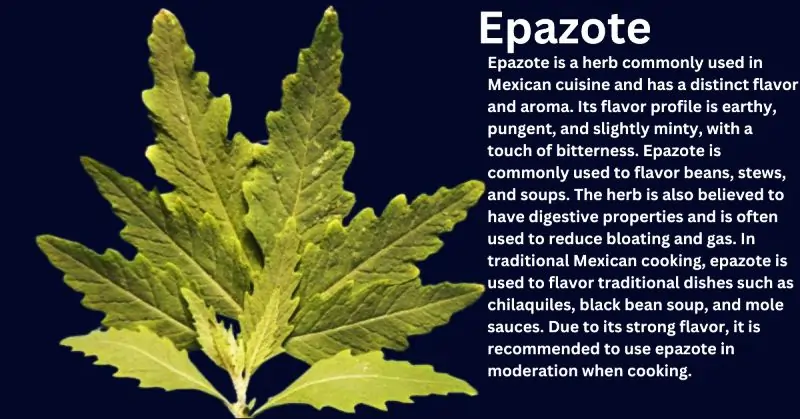
Epazote is a herb commonly used in Mexican cuisine and has a distinct flavor and aroma. Its flavor profile is earthy, pungent, and slightly minty, with a touch of bitterness. Epazote is commonly used to flavor beans, stews, and soups. The herb is also believed to have digestive properties and is often used to reduce bloating and gas. In traditional Mexican cooking, epazote is used to flavor traditional dishes such as chilaquiles, black bean soup, and mole sauces. Due to its strong flavor, it is recommended to use epazote in moderation when cooking.
Recipes that use epazote
Here are some recipes that use epazote:
- Black Bean Soup: Add a few sprigs of fresh epazote to a pot of black bean soup to add flavor and reduce gas.
- Chilaquiles: Fry corn tortillas until crispy, then toss with a spicy tomato sauce and epazote. Top with crumbled queso fresco and chopped onion.
- Mole Sauce: Use a combination of epazote, dried chili peppers, and Mexican chocolate to make a rich and flavorful mole sauce.
- Mexican Rice: Add chopped fresh epazote to rice as it cooks, along with diced tomatoes and onions, for a flavorful and colorful side dish.
- Refried Beans: Cook pinto beans with a few sprigs of epazote to add flavor and reduce gas. Mash the beans and serve as a side dish or filling for tacos.
Mexican oregano
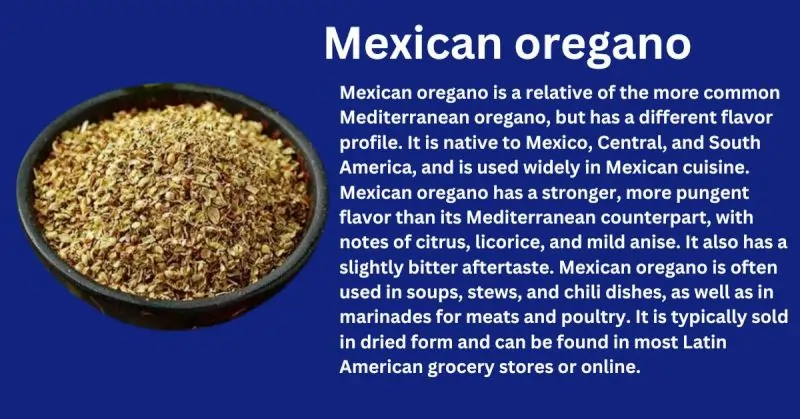
Mexican oregano is a relative of the more common Mediterranean oregano, but has a different flavor profile. It is native to Mexico, Central, and South America, and is used widely in Mexican cuisine. Mexican oregano has a stronger, more pungent flavor than its Mediterranean counterpart, with notes of citrus, licorice, and mild anise. It also has a slightly bitter aftertaste. Mexican oregano is often used in soups, stews, and chili dishes, as well as in marinades for meats and poultry. It is typically sold in dried form and can be found in most Latin American grocery stores or online.
Recipes that use Mexican oregano
Mexican oregano is a versatile herb that can be used in a wide range of Mexican dishes. Here are some recipes that use Mexican oregano:
- Chicken Tinga Tacos: Mexican oregano is a key ingredient in the spicy tomato sauce that tops these shredded chicken tacos. The oregano adds a depth of flavor that complements the smoky chipotle peppers.
- Pozole Rojo: This traditional Mexican soup is made with hominy, pork, and a rich, spicy broth flavored with Mexican oregano. The herb gives the soup a slightly bitter, earthy flavor that balances the sweetness of the hominy.
- Carne Asada: This grilled beef dish is marinated in a mixture of Mexican oregano, garlic, cumin, and lime juice. The oregano adds a distinctive flavor that sets this dish apart from other grilled meats.
- Salsa Verde: This tangy green salsa is made with tomatillos, jalapeños, and Mexican oregano. The oregano gives the salsa a slightly bitter note that balances the sweetness of the tomatillos.
- Black Bean Soup: This hearty soup is flavored with Mexican oregano, cumin, and coriander. The oregano adds a depth of flavor that complements the earthiness of the black beans.
Overall, Mexican oregano is a versatile herb that can add a distinctive flavor to a wide range of Mexican dishes.
Tips for cooking with Mexican herbs and spices
Here are some tips for cooking with Mexican herbs and spices:
- Start with small amounts: Mexican herbs and spices can be very potent, so it’s important to start with small amounts and add more as needed.
- Toast the spices: Toasting spices like cumin and paprika in a dry skillet before using them can help bring out their flavors.
- Use fresh herbs: Fresh herbs like cilantro and epazote have a more intense flavor than their dried counterparts.
- Experiment with combinations: Don’t be afraid to experiment with different combinations of herbs and spices to find your favorite flavor profiles.
- Add at the right time: Some herbs and spices, like cilantro and epazote, are best added towards the end of cooking to preserve their flavors, while others, like cumin and chili powder, can be added earlier on.
- Store properly: To maintain their freshness and flavor, store Mexican herbs and spices in a cool, dry place away from direct sunlight. Dried herbs and spices should be stored in airtight containers.
- Have fun: Cooking with Mexican herbs and spices is all about having fun and experimenting. Don’t be afraid to try new things and make your own unique flavor combinations.
How to store and use these ingredients properly
Proper storage of Mexican herbs and spices can help to maintain their quality and flavor for longer periods. Here are some tips:
- Store in a cool, dry place: Herbs and spices should be stored in airtight containers in a cool, dry place away from heat and moisture. Avoid storing them near the stove or in direct sunlight.
- Label and date: Label each container with the name and date of purchase. This will help you keep track of when to replace them.
- Grind whole spices when needed: Whole spices can be stored for longer periods than ground spices. Grind them as needed to preserve their freshness and flavor.
- Use fresh herbs when possible: Fresh herbs can add a lot of flavor to dishes, but they don’t last as long as dried herbs. Use them as soon as possible or freeze them for later use.
- Don’t overuse: While herbs and spices can add a lot of flavor to dishes, too much can overpower the other flavors. Use them sparingly and taste as you go to find the right balance.
When using Mexican herbs and spices in cooking, consider the flavor profile of each ingredient and how it will complement the other ingredients in the dish. Use them to enhance the natural flavors of meats, vegetables, and grains. Don’t be afraid to experiment with different combinations to find your perfect flavor profile.
Blog Post Conclusion
In conclusion, Mexican herbs and spices play a crucial role in elevating the flavors and nutritional value of dishes. From the bold and spicy flavor of chili powder to the fresh and citrusy taste of cilantro, these ingredients have become essential in Mexican cuisine. By understanding their unique flavor profiles and following proper storage and cooking techniques, anyone can incorporate these herbs and spices into their cooking repertoire. Whether you’re a seasoned chef or just starting in the kitchen, adding these Mexican herbs and spices to your dishes is sure to impress your taste buds and elevate your meals to the next level.
FAQ on Mexican Herbs and Spices
What are some common Mexican herbs and spices?
Some common Mexican herbs and spices include chili powder, cilantro, cumin, oregano, and paprika.
What are the health benefits of using herbs and spices in Mexican cuisine?
Herbs and spices used in Mexican cuisine can provide antioxidants, anti-inflammatory compounds, and essential oils that can boost the immune system, aid digestion, and reduce the risk of chronic diseases.
How can I store Mexican herbs and spices properly?
Mexican herbs and spices should be stored in airtight containers in a cool, dry place away from direct sunlight to maintain their flavor and aroma.
What are some common mistakes to avoid when cooking with Mexican herbs and spices?
Common mistakes include using too much or too little of the herb or spice, not toasting the spices before using them, and not using fresh herbs when required.
